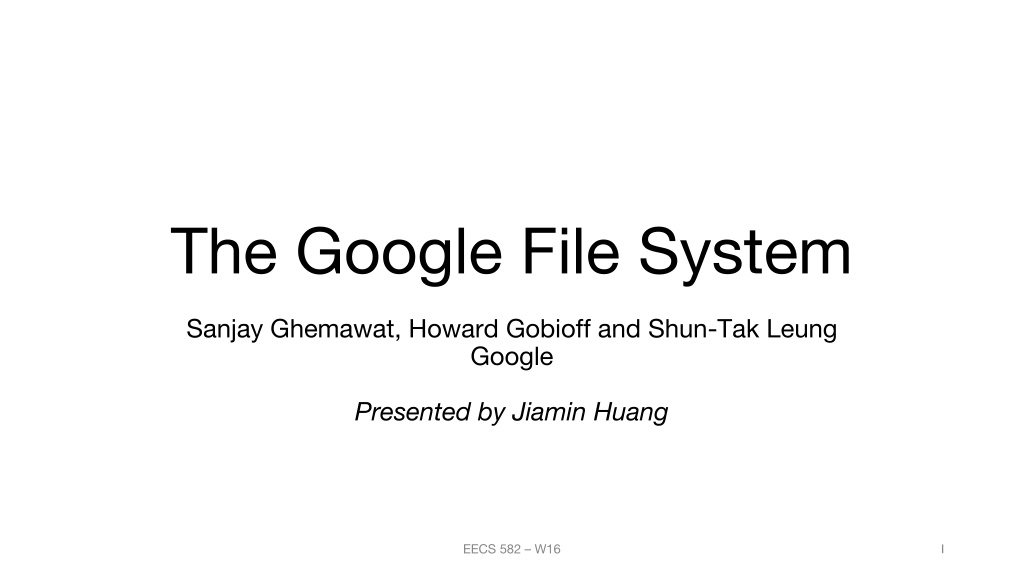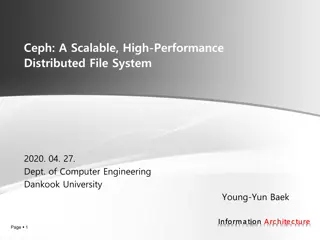Understanding The Google File System Architecture
This content delves into the architecture of The Google File System, discussing key components such as master operations, chunk servers, and system interactions for both read and write operations. The system's design emphasizes fault tolerance, scalability, and efficient data storage and retrieval.
Download Presentation

Please find below an Image/Link to download the presentation.
The content on the website is provided AS IS for your information and personal use only. It may not be sold, licensed, or shared on other websites without obtaining consent from the author. Download presentation by click this link. If you encounter any issues during the download, it is possible that the publisher has removed the file from their server.
E N D
Presentation Transcript
The Google File System Sanjay Ghemawat, Howard Gobioff and Shun-Tak Leung Google Presented by Jiamin Huang 1 EECS 582 W16
Problem Component failures are the norm Files are huge Appends are common; random writes are rare Co-designing the applications and file system API increases flexibility 2
Master Single master Metadata File and chunk namespaces Mapping from files to chunks Locations of each chunk s replica Replicate using operation log Read-only shadow masters 4
Master operations Namespace management using locks Place chunk replicas across racks Replicate chunks for higher availability Moves chunks around for disk space and load balancing Garbage collection Deleted files Stale replicas Lazy reclaim 5
Chunkserver Multiple chunkservers Free to join and leave Stores actual data Report chunk locations to master Checksums the data for integrity Replicated by the master 6
Interface Normal operations: create, delete, open, close, read, write Additional operations Snapshot Create copy of file or directory tree Copy-on-write Record append Atomic Returns the offset to the client 7
System Interaction - Read 1.Client sends file name and chunk index to master Can be multiple chunks 2.Master returns replica locations May return locations for the next chunks 3.Client sends request to a chunkserver 4.Chunk servers returns the data 5.Further reads require no client-master interaction 8
System Interaction - Write 1.Master selects a primary chunkserver and grants a lease 2.Client asks master the location of primary and secondaries 3.Client pushes the data to all replicas 4.All replicas reply to the client 5.Client sends write request to primary 6.Primary executes request, forwards it to secondaries 7.Secondaries replay all mutations in the order of the primary 9
System Interaction - Append Same as write Primary pads the chunk if space is not enough and client retries Each append is at most of the chunk size Large appends are broken into multiple operations 10
Consistency Model Consistency level Defined Consistent Inconsistent Implications for applications Rely on appends rather than overwrites Checkpoint Use self-validating, self-identifying records 11
Evaluation - Real world clusters Cluster A Research and Development A few MBs to a few TBs of data Tasks run up to hours Cluster B Production use Continuously generate and process multi-TB data Long running tasks 13
Recovery Time Kill one chunkserver 15000 chunks containing 600 GB data All chunks restored in 23.2 mins Kill two chunkservers Each with 16000 chunks and 660 GB data Results in 266 single replicas Single replicas restored to at least 2x within 2 mins 16
Conclusion Some assumptions no longer hold Failures are normal Optimize for large files Optimize for appends Fault tolerance Constant monitoring Replication Fast recovery 17
Flat Datacenter Storage (FDS) Bisection, high bandwidth network Flat storage model Non-blocking API Single master, multiple tractservers Deterministic data placement Dynamic work allocation with small work unit Parallel writes to all replicas Parallel replication 18
Tachyon Pushes lineage into the storage layer Lineage information is persisted before the actual data Asynchronous, selective checkpointing Leaves and hot files first Resource allocation based on job priority Uses client side caching to increase replication factor 19
Discussion How should the design be changed to handle small files? How to use multiple masters to avoid SPOF? How can consistency be improved? 20























